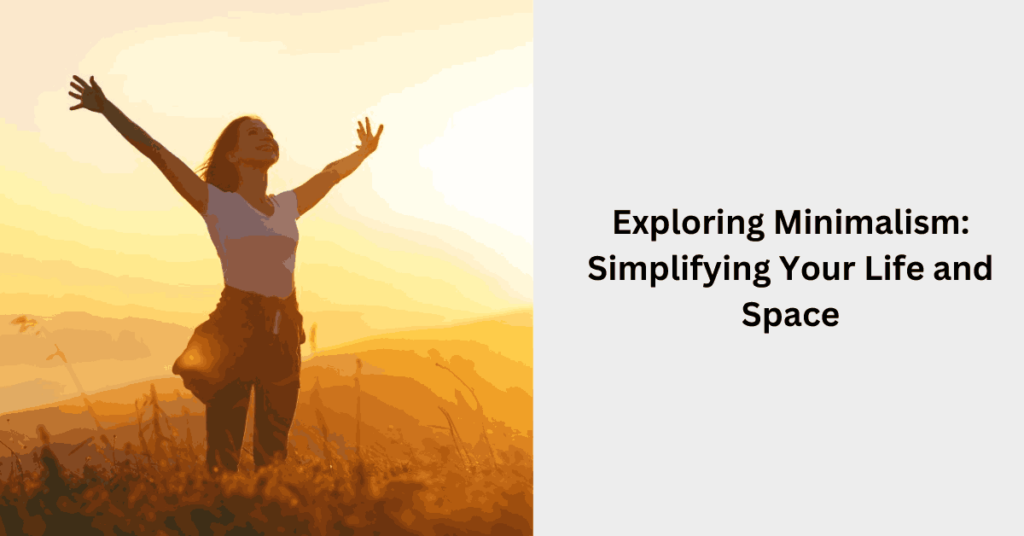Exploring Minimalism: Simplifying Your Life and Space

In a world often characterized by excess and constant stimulation, the philosophy of minimalism has gained traction as a powerful antidote.
Minimalism is more than a design aesthetic; it’s a lifestyle that encourages intentional living, focusing on what truly matters and decluttering both physical and mental spaces.
Let’s embark on a journey of exploration into minimalism, uncovering how it can simplify your life and create a sense of harmony and purpose.
Table of Contents
Understanding Minimalism:
At its core, minimalism is about embracing simplicity and decluttering, stripping away the non-essential to make room for what adds value and meaning to your life. This philosophy encourages individuals to be deliberate in their choices, fostering a mindful and intentional approach to consumption, possessions, and overall lifestyle.
Simplifying Your Physical Space:
1. Decluttering:
Start by decluttering your living spaces. Assess your belongings and ask yourself if each item serves a purpose or brings joy. Discard or donate items that no longer hold significance. The goal is to create an environment where every possession has a purpose and contributes to a sense of calm.
2. Quality Over Quantity:
Shift your focus from accumulating numerous possessions to investing in high-quality, essential items. Choose items that are durable, versatile, and align with your values. This not only reduces clutter but also enhances the aesthetic and functionality of your space.
3. Multi-Functional Furniture:
Opt for furniture that serves multiple purposes. This not only saves space but also promotes a minimalist aesthetic. For example, a bed with built-in storage or a dining table that can also function as a workspace.
4. Neutral Color Palette:
A minimalist color palette often revolves around neutral tones such as whites, grays, and earthy hues. This creates a calming and cohesive visual environment, allowing key elements to stand out without overwhelming the senses.
5. Empty Spaces:
Embrace empty spaces as a deliberate design choice. Allow room for your eyes and mind to rest. Minimalism is not just about what you have but also about what you choose not to have.
Simplifying Your Digital Space:
1. Digital Declutter:
Extend the principles of minimalism to your digital life. Organize and declutter your digital files, emails, and apps. Delete or archive what is unnecessary and streamline your digital space for increased efficiency.
2. Mindful Social Media Use:
Evaluate your social media presence and choose platforms mindfully. Unfollow accounts that do not align with your values or bring positivity into your life. Limit your time on social media to avoid information overload.
3. Digital Detox:
Consider periodic digital detoxes. Designate specific times to disconnect from screens, allowing your mind to unwind and focus on the present moment.
Simplifying Your Lifestyle:
1. Mindful Consumption:
Practice mindful consumption by being intentional about your purchases. Before buying something, consider its necessity and long-term value. Quality often outweighs quantity in a minimalist lifestyle.
2. Prioritizing Experiences:
Shift the focus from acquiring possessions to accumulating experiences. Invest in activities and moments that bring joy, fulfillment, and lasting memories.
3. Clearing Mental Clutter:
Minimalism extends beyond physical possessions; it encompasses mental well-being. Practice mindfulness, meditation, or journaling to clear mental clutter and foster a sense of calm.
4. Intentional Time Management:
Simplify your schedule by prioritizing tasks that align with your goals and values. Say no to commitments that do not contribute positively to your life.
Benefits of Minimalism:
- Reduced Stress: A clutter-free environment and simplified lifestyle contribute to reduced stress and anxiety.
- Increased Focus: By eliminating distractions and non-essential elements, minimalism allows for increased focus on what truly matters.
- Enhanced Well-Being: Living with intention and mindfulness promotes a sense of well-being and contentment.
- Financial Freedom: Mindful consumption leads to smarter spending choices, potentially freeing up financial resources for more meaningful pursuits.
- Environmental Impact: By consuming less and choosing quality over quantity, minimalism aligns with sustainable and eco-friendly practices.
Conclusion:
Embracing minimalism is a personal journey of self-discovery and intentional living. It’s about consciously choosing simplicity over excess, focusing on quality over quantity, and cultivating a life that aligns with your values. Whether you’re decluttering your physical space, simplifying your digital life, or adopting a minimalist mindset, the principles of minimalism offer a path to a more intentional, fulfilling, and harmonious way of living.


